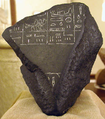Mast (hieroglyph)
| ||
| Mast hieroglyph #2 in hieroglyphs | ||
|---|---|---|
| ||
| Ship's Mast in hieroglyphs | ||
|---|---|---|
The ancient Egyptian Mast hieroglyph is one of the oldest language hieroglyphs from Ancient Egypt. It is used on a famous label of Pharaoh Den of the First dynasty, but forms part of the location hieroglyph: Emblem of the East.
| |
The Ship's Mast hieroglyph is used as a triliteral phonetic hieroglyphic to represent the sound sequence ꜥḥꜥ, which means "to stand erect", or "to stand vertical"; its use is extensive throughout the language history, and hieroglyphic tomb reliefs and story-telling of Ancient Egypt. It is possibly a forerunner hieroglyph kh3 [clarification needed], the sun rising upon the horizon.
In the 198 BC Rosetta Stone, the ship's mast hieroglyph has the unique usage in the final line of the Ptolemy V decree: the mast is used twice-(adjective, verb):
- engrave the decree..: "...upon a vertical-(mast) stone stele"..in the 3-language scripts, .."Shall be made to stand it in the sanctuaries in temples all..."
-
Ship's Mast on label of Pharaoh Den, 1st Dynasty
-
From right, hieroglyphs: sedge of the South, Papyrus clump with leaves of North-Nile Delta, wife-hieroglyph, the tree-hieroglyph, and the Ship's Mast hieroglyph
-
Cartouche amulet, with variant form of mast hieroglyph
-
Old Kingdom of Ancient Egypt: Palermo stone fragment
-
Nectanebo II obelisk, stating that he 'erected' the obelisk, (using the Mast-hieroglyph)
See also[edit]
- Gardiner's Sign List#P. Ships and Parts of Ships
- Gardiner's Sign List#U. Agriculture, Crafts, and Professions
- List of Egyptian hieroglyphs by common name: M-Z
- Mast
References[edit]
- Budge. An Egyptian Hieroglyphic Dictionary, E.A.Wallace Budge, (Dover Publications), c 1978, (c 1920), Dover edition, 1978. (In two volumes) (softcover, ISBN 0-486-23615-3)
- Budge. The Rosetta Stone, E.A.Wallace Budge, (Dover Publications), c 1929, Dover edition(unabridged), 1989. (softcover, ISBN 0-486-26163-8)





